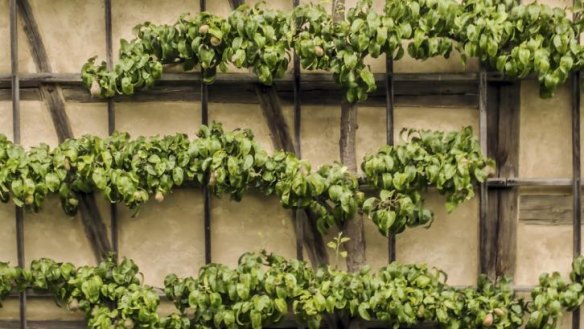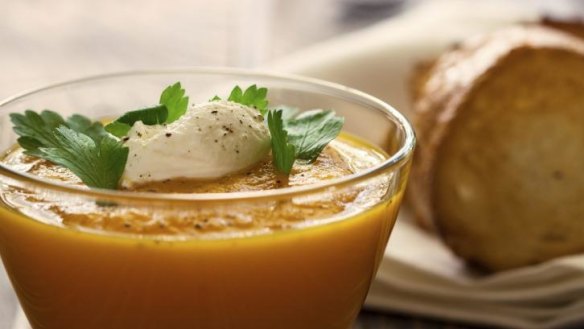Owen Pidgeon: Secrets of growing fruit trees for Canberra gardeners

Planting your own fruit trees means making a long-term commitment. You will need to consider many aspects if afterwards you will be able to enjoy the "fruits of your labour".
Among the most critical aspects are sunshine, reasonable soil, good drainage and space. The introduction of dwarf rootstocks has helped address the last of these four. Other elements that are also important are tree management including the need for cross pollination, coping with cold winters and hot, dry summers, and tree maintenance.
Then there is the big issue of managing pests and diseases, especially if you have close neighbours who care little for your desire to grow your own healthy foods. Lots to think about before you rush in and waste funds on something that will not work out. Caveat emptor is the old legal Latin phrase: buyer beware because if you can manage everything you will enjoy the most delicious fruit and be very satisfied that you grew it yourself.

Fruit trees enjoy lots of sunshine and need to have good drainage. They are shallow rooted, without a tap root but most species cannot stand to be in waterlogged soil. Stone fruits such as cherries, peaches and apricots need the best drainage to prosper. The best survivors for very heavy soils are pear and quince trees but even then you should dig down to around 40 centimetres and back fill with some smallish rubble to provide for drainage.
How much space do you require? One thing to remember is that most fruiting trees need cross pollination to produce their crops. A double or triple-grafted tree is one solution for small spaces. As well, now that many species of fruit trees have been grafted on to dwarfing rootstocks, the spacing between trees can generally be reduced down to 1.5 metres. This compares favourably to the advice of years ago when all trees would grow into very large specimens, requiring planting distances of three to four metres between each tree.
Consider espaliering your trees along your back fence, or growing them like a hedge, close together. I have seen one city garden where there is a row of 10 apple trees planted along the back fence. Each tree will produce less fruit but the owners will have greater variety over the harvest season and the total amount of fruit will be quite high.
Fruit trees need care throughout the year and it is a sorry sight to see trees that have been left untouched and unpruned for too long. You will need to either have the time to prune over the winter months or pay someone to do this for you. On timing, the exception is cherry and apricots which are best done in late summer after harvest, to avoid infection from cuts that that time to heal.
The highlands regions are either good or bad for fruit trees, with their cold winter nights and frosts lying heavy on the ground in July and August. Temperate region trees do need several hundred hours of chill hours, with apple and pears requiring more than many others. That is usually fine for these fruits, as their blossoms appear only in late September and early October. However, as apricots flower in mid August and peaches and nectarines follow closely behind, very cold nights during the blossom time can wipe out the entire crop.
I love apricots and my wife, Noreen, loves nectarines so we persist with growing some varieties of each in the full knowledge that some years the cold nights will get the better of those trees. Then again, in the past 25 years we have experienced two late spring nights (late October) when an all-night inversion frost killed off all the apple and pear crop as well. C'est la vie.
Finally, a note on pests and diseases. In some respects, the attacks by birds including starlings and cockatoos and the devastation caused by fruit bats have resulted in many city people giving up growing their own fruit. The solution is to prune back the height of all your fruit trees quite rigorously and then totally cover with a good quality bird net (white woven nets, as used by the vineyards). Buy ample netting to drape it right down to ground level, enough for some to lie on the ground.
Fruit fly is also endemic in many city locations. This can have a devastating effect, especially on soft stone fruits (and tomatoes) in any backyard. The best natural aid is a long cold winter with many frosty nights to kill off the overwintering larvae. However, again with any new outbreak, you will need to cover with a finely woven net and consider spraying with the natural insecticide spinosad. It is a natural substance made from a soil bacterium used to control a wide variety of pests, including thrips, leafminers, and fruit flies.
If you consider planting cherry, pear or quince trees then the major pest problem will be the pear and cherry slug. This can be controlled by spraying with a natural pyrethrum spray (or by sprinkling talcum powder on the leaves, or even folding over individual leaves and squishing the slugs). There can be two or three cycles of the slug over summer, with the first cycle appearing in November. If left untreated, the leaves will be devastated.
Growing apple trees in the home garden will give you two specific challenges. The worst disease is apple scab (black spot on the skin surface) and the worst pest is codling moth. Over winter, rake up all fallen leaves from under your apple trees. They can be composted if you plan to only use your compost later when growing vegetables. Apple scab is a fungus which overwinters on fallen fruit and leaves. The ascospores will float back up to infect newly set fruit in springtime, when the spores are released by raindrops. We use a modest spraying regime of lime sulphur to control apple scab, at 1 per cent solution, but you will need to make regular applications up until Christmas time. Later applications are needed if there are big summer storms and evidence of continuing spore activity.
Codling moths leave their larvae on apples and the impact is severe. In big orchards there is a biological control which disrupts the mating program by drawing the male moth away from the female moth. This isomate needs a canopy extending to ¼ acre to be really effective. For the backyard garden, you can hang a zapper light in the top of your biggest apple tree and turn it on at dusk to attract the male moths. Also, be willing to simply inspect all the apples on your trees in early December and remove infected apples. Take a radio and enjoy the peace and quiet. Remember that codling moth will only fly up to 150 metres from its base so if you can clean up your trees early in the season, then there is a good chance that you can prevent the second generation of moths from causing more problems in late summer.
Peach and nectarine trees have a very specific springtime fungal disease. It is called leaf curl and by the time you see it on the new leaves, it is too late to prevent the problem. Treat with a copper sulphate-based spray such as Kocide. The spraying needs to be completed at bud swell, just before the leaves emerge. If you miss doing this in August your trees may have all their leaves infected and misshapen by mid-September. You will then need to "sit it out" and wait for these leaves to dry out and fall off. Dispose of all infected leaves; do not put into the compost. Then hope that the tree is strong enough to produce a new set of leaves. If these later leaves appear, they will not be infected.
Next week: my favourite, reliable cultivars for temperate climate fruit trees.
Spicy pear and sweet potato soup
3 Josephine or winter nelis pears
500g sweet potato
1 onion, finely chopped
1 tbsp olive oil
2 cloves garlic, crushed
2 tsp chilli powder
½ tsp paprika
4 cups vegetable stock
salt and pepper
Peel and chop the pears and sweet potato into cubes. Heat oil in a heavy-based saucepan and fry the onion and garlic until soft. Add the pears, sweet potato and spices and fry to brown. Add in the vegetable stock and simmer until the pears and sweet potato become soft. Remove from heat and blend well. Return to the pot and reheat, seasoning with salt and pepper. Serve with crusty bread.
This week in the garden
* Plant out strawberry runners along hilled-up rows of your garden bed, after adding generous quantities of compost. Make the rows wide enough to plant twin rows and leave 15 centimetres between each plant.
* Plant rhubarb crowns into a bed which has been prepared with compost dug deeply to feed the root systems. Long-living plants can be carefully dug up with a garden fork and divided. Leave 45-50 centimetres between plants. Keep the terminal bud just above the top of the soil when planting each set.
* Undertake your winter pruning of brambleberry canes, cutting off the old canes at ground level and tying up the new-season canes in clusters of four to six, along trellis wires.
* Keep tidying up around your fruit trees, disposing of any fallen fruit and adding leaves to the compost.
Owen Pidgeon runs the Loriendale Organic Orchard near Hall.
Restaurant reviews, news and the hottest openings served to your inbox.
Sign up